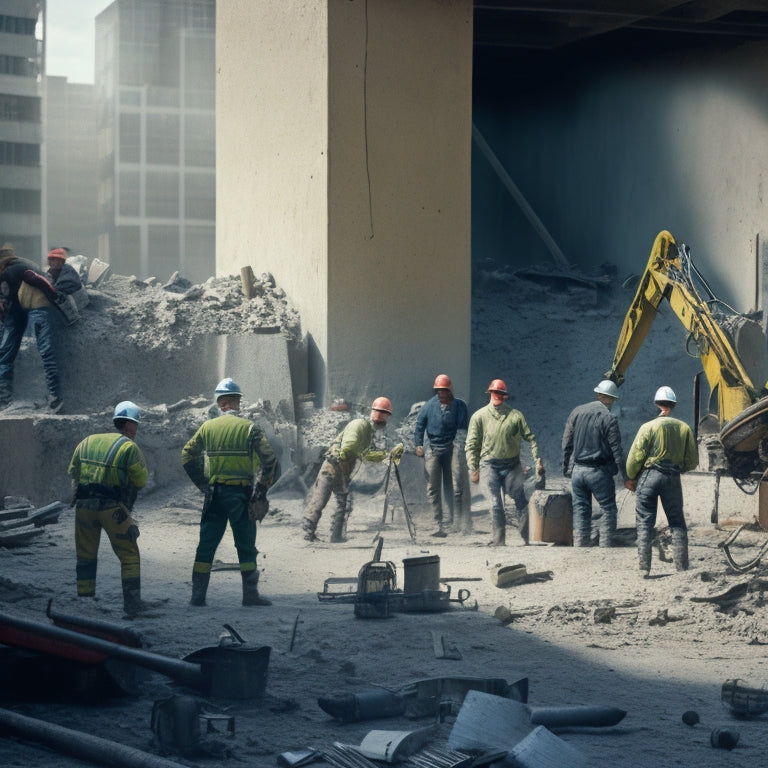
Top Tools for Easy Concrete Removal
Share
When it comes to efficient concrete removal, you'll need a strategic combination of specialized tools. Demolition hammers, pry bars, chisel sets, hammer drills, and jackhammers are all essential for breaking, separating, and drilling through concrete. Don't forget to prioritize safety with protective gear like safety goggles, gloves, and a dust mask. Additionally, consider investing in dust control systems and wheelbarrows for easy debris removal. With the right tools and techniques, you'll be well on your way to a successful demolition project. Now, take a closer look at each tool and discover how to maximize their effectiveness for your specific concrete removal needs.
Key Takeaways
• Demolition hammers are essential for concrete removal, with options for electric, pneumatic, or gasoline-powered tools suitable for various projects.
• Pry bars are effective for breaking concrete into smaller sections by identifying weak points and applying gradual force with controlled leverage techniques.
• Chisel sets with high-quality materials like tungsten carbide or diamond-coated tips enhance control and efficiency during removal, with proper angle of attack and force application.
• Hammer drills and jackhammers provide powerful mechanisms for drilling and demolition, with carbide-tipped bits and regular maintenance ensuring peak performance.
• Using dust control systems, safety gear, and force control techniques can make concrete removal easier, safer, and more efficient, while wheelbarrows facilitate debris removal.
Essential Safety Gear for Removal
You'll frequently encounter hazardous materials and heavy equipment during concrete removal, making it crucial to wear essential safety gear to prevent injuries and fatalities. As you work with concrete, you'll be exposed to flying debris, chemical splashes, and heavy machinery, which can cause serious harm if you're not properly protected.
To minimize the risks, always wear safety goggles to shield your eyes from flying particles and chemical splashes. Additionally, don protective gloves to prevent cuts, abrasions, and skin irritation from handling rough concrete surfaces and chemicals. These gloves should be resistant to punctures, tears, and abrasion, and provide grip to prevent dropping tools or materials.
Furthermore, consider wearing a dust mask or respirator to filter out airborne particles and dust, which can cause respiratory problems. Steel-toed boots and a hard hat are also essential to protect your feet and head from falling objects and debris.
Demolition Hammers for Breaking
When tackling concrete removal, your arsenal should include a reliable demolition hammer, a powerful tool capable of delivering high-impact blows to break up and demolish concrete structures efficiently. This essential tool is designed to withstand the rigors of concrete demolition, providing you with the necessary force to shatter and remove concrete quickly and safely.
To maximize the effectiveness of your demolition hammer, it's vital to choose the right one for the job. Consider the following factors:
| Factor | Consideration |
|---|---|
| Weight | Lighter hammers for smaller projects, heavier for larger ones |
| Power Source | Electric, pneumatic, or gasoline-powered, depending on your needs |
| Bit Type | Chisel, point, or flat bits for different demolition techniques |
| Handle Material | Durable materials like steel or fiberglass for reduced fatigue |
| Maintenance | Regularly inspect and maintain your hammer to prevent wear and tear |
Pry Bars for Block Separation
When you're using pry bars for block separation, you'll focus on three key points.
First, you'll break up the block into manageable pieces, creating cracks and weaknesses that allow you to gain leverage.
Next, you'll use that leverage to pry the pieces apart.
Break Up the Block
One of the most effective ways to break up a concrete block is by using pry bars to separate it into manageable sections. When tackling different block types, you'll find that this technique is particularly useful for larger, heavier blocks that would be difficult to remove in one piece.
To break up the block, follow these steps:
-
Identify the weakest points: Look for cracks, fissures, or other areas where the concrete is already compromised. These will be your points of entry for the pry bar.
-
Position the pry bar: Place the pry bar in the identified weak point, ensuring it's securely wedged in place.
-
Apply force: Use your body weight or a hammer to apply force to the pry bar, slowly prying the block apart.
- Repeat and separate: Continue to repeat the process, working your way around the block until it's broken into smaller, manageable sections.
Leverage and Pry
By applying calculated force with a pry bar, you can exploit the inherent weaknesses in a concrete block, ultimately separating it into manageable pieces. This approach relies on lever techniques, which allow you to amplify your input force, making it easier to pry the block apart.
To effectively utilize pry mechanics, it's crucial to identify the block's stress points, typically located at the joints or cracks. Position the pry bar at these points, then apply slow, controlled pressure. As the block begins to shift, reposition the bar to maintain ideal leverage.
Remember to maintain a secure grip on the pry bar, using your body weight to generate force when necessary. Avoid using sudden or jerky motions, as these can cause the bar to slip or the block to shatter uncontrollably.
Separate the Pieces
You'll typically need to separate the concrete block into smaller, more manageable pieces before removal, and pry bars are ideal for this task. This step is essential in your project planning, as it allows you to tackle the job more efficiently.
When using pry bars for block separation, consider the following techniques overview:
-
Insertion points: Identify the natural cracks or joints in the concrete block and insert the pry bar, using it as a wedge to separate the pieces.
-
Leverage application: Apply gentle to moderate pressure to the pry bar, depending on the size and thickness of the block, to pry the pieces apart.
-
Block manipulation: Once separated, use the pry bar to manipulate the pieces into more manageable sizes, making them easier to remove.
- Safety precautions: Always wear protective gear, including gloves and safety glasses, when working with pry bars to avoid injury.
Chisel Sets for Precision Removal
When selecting a chisel set for precision concrete removal, you'll want to evaluate the material it's made of, as this affects its durability and performance.
You'll also need to think about the angle at which you'll be striking the concrete, as this impacts the effectiveness of the removal process.
Chisel Material Matters
The type of material used in your chisel set greatly impacts the efficiency and effectiveness of concrete removal, as different materials excel in various tasks and environments. When it comes to chisel types, you'll want to take into account the specific demands of your project.
Here are four key material options to take into account:
-
Carbon Steel: A popular choice for general-purpose chiseling, carbon steel chisels offer a balance of strength, durability, and affordability.
-
High-Speed Steel (HSS): Ideal for heavy-duty concrete removal, HSS chisels feature enhanced hardness and heat resistance, making them perfect for demanding tasks.
-
Tungsten Carbide (TC): For extreme toughness and wear resistance, TC chisels are the way to go. They're particularly useful for breaking up thick, reinforced concrete.
- Diamond-Coated: These chisels feature a diamond-coated edge, which provides exceptional cutting performance and longevity, even in the most abrasive environments.
Proper chisel maintenance is also essential to extend the life of your tools and guarantee peak performance.
Regularly inspect and clean your chisels, and take into account resharpening or replacing them as needed to maintain peak efficiency.
Angle of Attack
By adjusting the angle of attack, you can precision-target specific areas of concrete, achieving a more controlled and efficient removal process. This technique is vital when working with chisel sets, as it allows you to navigate complex structures and remove concrete with precision.
When using a chisel set, it's important to maintain a consistent angle of attack to avoid damaging surrounding material. Experiment with different angles to find the most effective approach for your specific removal task.
A shallow angle of attack is ideal for removing thin layers of concrete, while a steeper angle is better suited for breaking up thicker sections. By adapting your removal techniques to the specific demands of the job, you can achieve faster and more accurate results.
Additionally, proper tool maintenance is essential to guarantee the longevity of your chisel set. Regularly inspect and clean your tools to prevent damage and maintain their effectiveness.
Force Control Techniques
You'll need to develop a keen sense of force control to effectively harness the precision removal capabilities of chisel sets. Chisel sets are designed for precise concrete removal, but their effectiveness relies on your ability to apply the right amount of force. Too little force, and the chisel won't penetrate the concrete; too much force, and you risk damaging the surrounding material or breaking the chisel.
To master force control, focus on the following techniques:
-
Gradual force application: Apply force gradually, increasing the pressure as needed to avoid sudden impacts that can cause damage.
-
Impact dynamics management: Control the angle and velocity of your strikes to optimize the force transmission and minimize rebound.
-
Force redirection: Learn to redirect the force of your strikes to maintain control and avoid losing momentum.
- Force modulation: Develop the ability to modulate your force application in real-time, adjusting to the changing concrete conditions and chisel performance.
Hammer Drills for Efficient Drilling
Equipped with a powerful hammering mechanism, your drill bits will penetrate concrete more efficiently, reducing the time and effort required to complete the job.
When it comes to hammer drills, you'll encounter various drill types, each suited for specific tasks. Rotary hammers, for instance, are ideal for drilling into concrete, brick, or block, while demolition hammers are better suited for heavier demolition work.
The type of bit material you choose is also essential. Carbide-tipped bits are a popular choice for drilling into concrete, as they provide excellent wear resistance and durability. Diamond-coated bits, on the other hand, are ideal for drilling into hard, abrasive materials like asphalt or reinforced concrete.
When selecting a hammer drill, consider the power output, as it directly affects the drilling speed and efficiency. Look for drills with high torque and BPM (beats per minute) ratings to tackle tough concrete removal tasks.
Additionally, consider the weight and ergonomics of the drill, as it will impact your comfort and control during extended use. By choosing the right hammer drill and bit combination, you'll be well-equipped to tackle a wide range of concrete removal tasks with ease and precision.
Jackhammers for Heavy-Duty Removal
When tackling heavy-duty concrete removal tasks that require intense force and power, a jackhammer is often the go-to tool for efficiently breaking up thick slabs, sidewalks, or foundations.
As you consider which jackhammer to use, you'll want to choose from the various types available, including electric, pneumatic, and hydraulic models. Each has its own strengths and weaknesses, so it's crucial to select the one best suited to your specific task.
To guarantee peak performance and extend the life of your jackhammer, you'll need to perform regular maintenance tasks, including:
-
Regularly inspecting and replacing worn or damaged components, such as bushings and seals.
-
Properly lubricating moving parts to reduce friction and wear.
-
Keeping the tool clean and free of debris to prevent damage and guarantee smooth operation.
- Storing the jackhammer in a dry, protected area to prevent damage from the elements.
Dust Control Systems for Clean Work
As you break up concrete with your chosen jackhammer, you'll generate massive amounts of dust that can pose serious health risks and compromise visibility, making it imperative to incorporate a dust control system into your workflow.
Dust control systems are designed to minimize airborne dust particles, ensuring a cleaner and safer work environment. One effective dust suppression technique is to use a dustless concrete saw, which utilizes a vacuum system to capture dust particles at the source.
Additionally, air filtration systems can be employed to remove airborne dust particles, further reducing the risk of respiratory issues. These systems typically consist of a series of filters that capture 99% of particles as small as 0.3 microns, providing a high level of air quality.
Wheelbarrows for Debris Removal
You'll need a reliable and sturdy wheelbarrow to efficiently haul away the broken concrete and debris generated during the removal process. This is a vital step in maintaining a clean and safe work site.
When it comes to wheelbarrows for debris removal, you have several options to choose from, each with its unique features and benefits. Here are some wheelbarrow types to take into account for effective debris handling:
-
Steel wheelbarrows: Heavy-duty and durable, ideal for hauling heavy loads of broken concrete and debris.
-
Poly wheelbarrows: Lightweight and resistant to corrosion, suitable for smaller-scale concrete removal projects.
-
Tipping wheelbarrows: Equipped with a tipping mechanism, making it easy to dump debris into a dumpster or pile.
- Utility wheelbarrows: Versatile and adaptable, featuring multiple compartments for separating different types of debris.
When selecting a wheelbarrow, think about the size and weight of the debris you'll be handling, as well as the terrain and obstacles on your work site.
Frequently Asked Questions
Can I Use a Regular Hammer for Concrete Removal?
When it comes to concrete removal, you're tempted to reach for a regular hammer, but hold on.
While it might seem like a good idea, a standard hammer isn't designed for concrete chiseling. You'll only end up with a damaged tool and a lot of wasted energy.
Instead, consider investing in specialized hammer types, like a demolition hammer or a chiseling hammer, specifically designed for concrete removal.
How Do I Prevent Injury From Flying Concrete Debris?
When breaking up concrete, you'll inevitably face flying debris. To prevent injury, you must prioritize safety.
Wear protective gear, including safety glasses, gloves, and a dust mask. Implement safety techniques, such as standing at an angle to the impact zone and keeping your body positioned behind the tool.
Keep bystanders at a safe distance and guarantee the area is clear of obstacles. By taking these precautions, you'll minimize the risk of injury and guarantee a successful concrete removal process.
What Is the Best Way to Dispose of Removed Concrete?
When disposing of removed concrete, you'll want to explore concrete recycling options to minimize waste and reduce environmental impact.
First, familiarize yourself with local disposal regulations to guarantee compliance.
Then, consider partnering with a reputable recycling facility or waste management company that can process the concrete into reusable aggregates.
Can I Rent Concrete Removal Equipment Instead of Buying?
You're considering renting concrete removal equipment instead of buying, and that's a smart move.
Before making a decision, you'll want to do a cost comparison.
Calculate the rental fees, including any additional costs for delivery, maintenance, and operation.
Weigh these against the purchase price, factoring in long-term maintenance and storage expenses.
This analysis will help you determine whether equipment rental is the most cost-effective option for your specific project needs.
How Do I Remove Concrete Without Damaging Surrounding Structures?
You're likely aware that a single misstep in concrete removal can cause $10,000 in damage to surrounding structures. To avoid this, you'll need to employ precise techniques.
Start by isolating the area with plywood or plastic sheets to contain debris.
Then, use hand tools like chisels, jackhammers, or saws to carefully break up the concrete.
Always maintain a safe distance from surrounding structures, and consider using protective barriers or shields to prevent damage.
Conclusion
You've made it through the tedious task of concrete removal, and congratulations are in order - you're still standing!
With these top tools, you've managed to dismantle the stubborn slab, dodged flying debris, and avoided a trip to the chiropractor (fingers crossed).
Pat yourself on the back, then grab a broom to sweep up the evidence of your hard work.
Now, go forth and conquer the next DIY project that dares to stand in your way!
Related Posts
-

Top Tools for Mixing Concrete at Home
When mixing concrete at home, you'll need a range of tools to guarantee a successful operation. Start with essential ...
-

Essential Tools for Epoxy Concrete Floor Repair
You'll need a thorough arsenal of specialized tools to guarantee a successful epoxy concrete floor repair. Floor prep...
-

Top Mixing Tools for DIY Concrete Block Laying
When it comes to DIY concrete block laying, the right mixing tools are vital for a strong and durable structure. You'...


